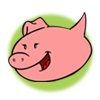
Uncovering America's Heritage... Coin by Coin
Barber or Liberty Head Half Dollar (1892–1915)
My, oh my... these coins were around a long time! This is Plinky the Mint Pig to tell you the story of the Barber half dollar, also known as the Liberty Head half dollar. In 1913, back when your great grandpa was working (most women stayed home in those days), he might have been paid in these half dollars. But in 1913, he would have had to give some of these coins back to the government. Why? Because on October 3, 1913, the law creating the federal income tax was signed.
I bet you've heard your parents talk about the income tax. It's the money they pay the government every April. How much you pay depends on how much you earn. In 1913, no one paid more than 7% of their income—that's 7 cents for every dollar they made. Today, the richest Americans pay about 40 cents for every dollar they earn.
What does the government do with all this money? They use it to run the country: to pay for things like our army, national parks, and highways; to keep the White House and government offices running; to pay the salaries of all government workers, from Mint Police to the President; and much more.
Designed by Charles Barber, the Mint engraver who was also known for his Barber dime, Barber quarter, and Liberty nickel, this coin was not popular at first. Most people thought the Lady Liberty on the obverse was not very pretty. However, the coin remained in circulation for a very long time—more than 25 years after the Mint stopped producing them.




